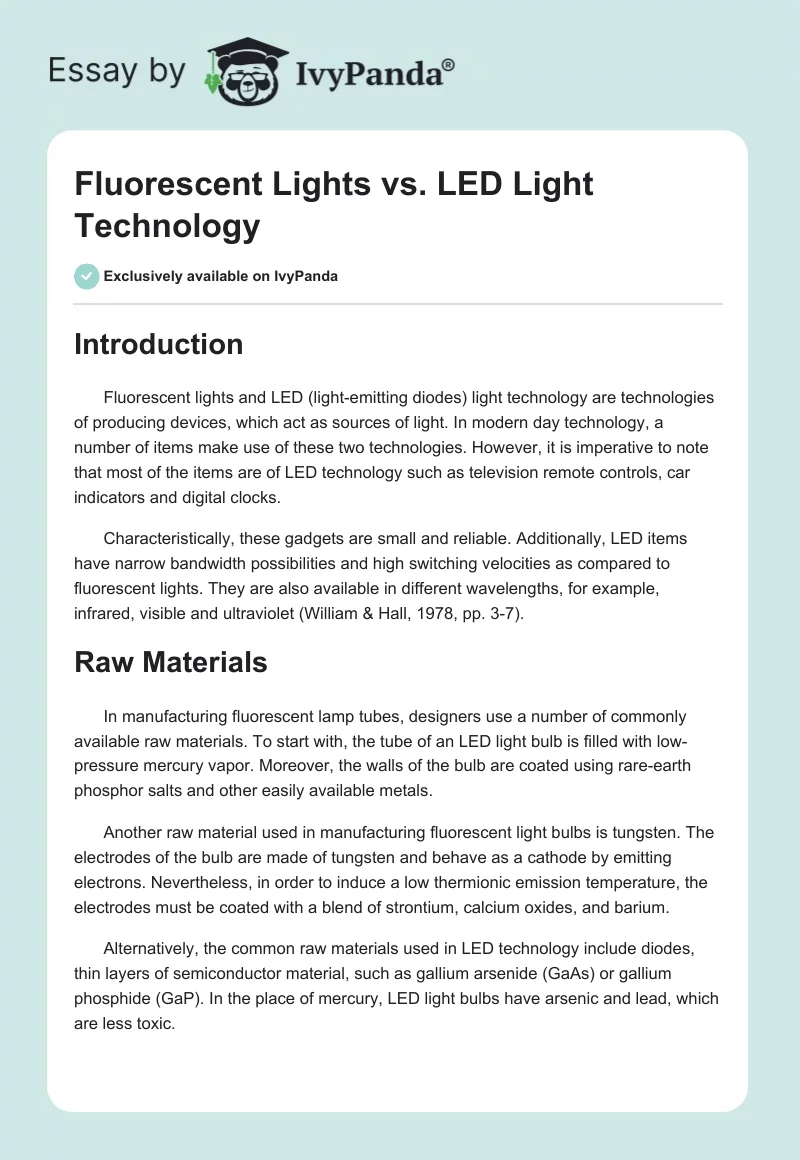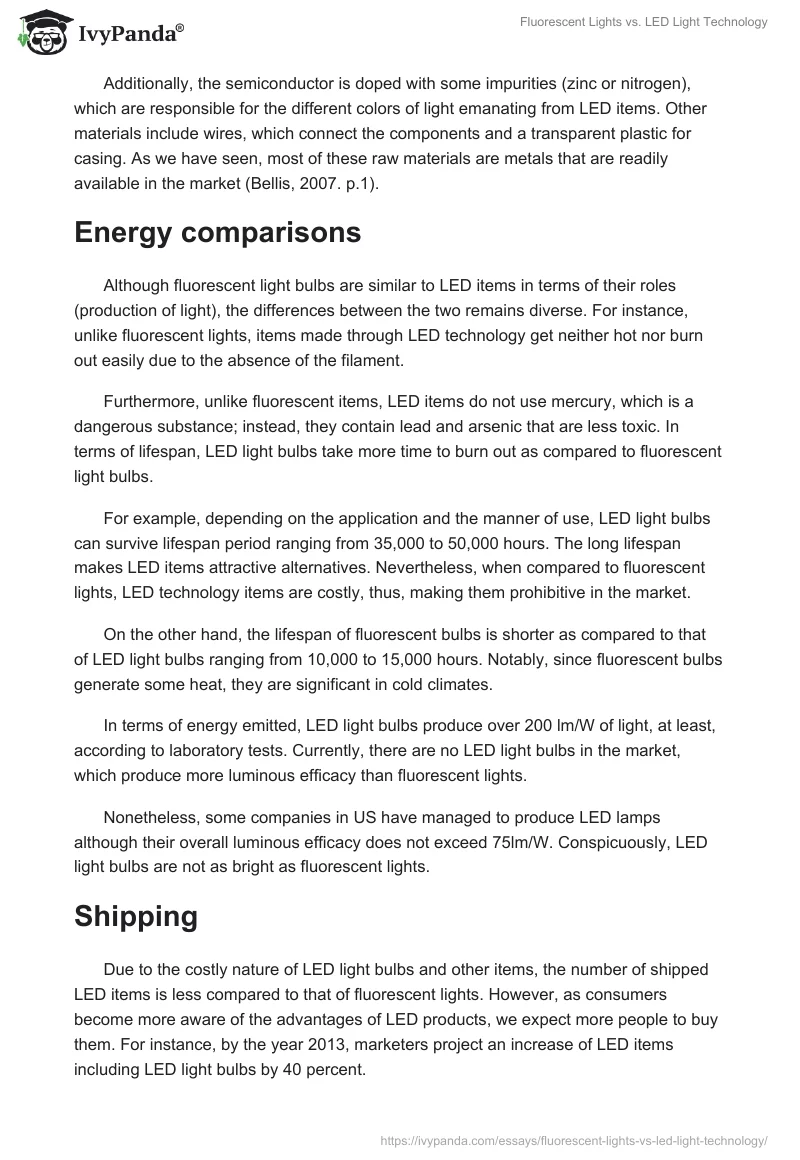Introduction
Fluorescent lights and LED (light-emitting diodes) light technology are technologies of producing devices, which act as sources of light. In modern day technology, a number of items make use of these two technologies. However, it is imperative to note that most of the items are of LED technology such as television remote controls, car indicators and digital clocks.
Characteristically, these gadgets are small and reliable. Additionally, LED items have narrow bandwidth possibilities and high switching velocities as compared to fluorescent lights. They are also available in different wavelengths, for example, infrared, visible and ultraviolet (William & Hall, 1978, pp. 3-7).
Raw Materials
In manufacturing fluorescent lamp tubes, designers use a number of commonly available raw materials. To start with, the tube of an LED light bulb is filled with low-pressure mercury vapor. Moreover, the walls of the bulb are coated using rare-earth phosphor salts and other easily available metals.
Another raw material used in manufacturing fluorescent light bulbs is tungsten. The electrodes of the bulb are made of tungsten and behave as a cathode by emitting electrons. Nevertheless, in order to induce a low thermionic emission temperature, the electrodes must be coated with a blend of strontium, calcium oxides, and barium.
Alternatively, the common raw materials used in LED technology include diodes, thin layers of semiconductor material, such as gallium arsenide (GaAs) or gallium phosphide (GaP). In the place of mercury, LED light bulbs have arsenic and lead, which are less toxic.
Additionally, the semiconductor is doped with some impurities (zinc or nitrogen), which are responsible for the different colors of light emanating from LED items. Other materials include wires, which connect the components and a transparent plastic for casing. As we have seen, most of these raw materials are metals that are readily available in the market (Bellis, 2007. p.1).
Energy comparisons
Although fluorescent light bulbs are similar to LED items in terms of their roles (production of light), the differences between the two remains diverse. For instance, unlike fluorescent lights, items made through LED technology get neither hot nor burn out easily due to the absence of the filament.
Furthermore, unlike fluorescent items, LED items do not use mercury, which is a dangerous substance; instead, they contain lead and arsenic that are less toxic. In terms of lifespan, LED light bulbs take more time to burn out as compared to fluorescent light bulbs.
For example, depending on the application and the manner of use, LED light bulbs can survive lifespan period ranging from 35,000 to 50,000 hours. The long lifespan makes LED items attractive alternatives. Nevertheless, when compared to fluorescent lights, LED technology items are costly, thus, making them prohibitive in the market.
On the other hand, the lifespan of fluorescent bulbs is shorter as compared to that of LED light bulbs ranging from 10,000 to 15,000 hours. Notably, since fluorescent bulbs generate some heat, they are significant in cold climates.
In terms of energy emitted, LED light bulbs produce over 200 lm/W of light, at least, according to laboratory tests. Currently, there are no LED light bulbs in the market, which produce more luminous efficacy than fluorescent lights.
Nonetheless, some companies in US have managed to produce LED lamps although their overall luminous efficacy does not exceed 75lm/W. Conspicuously, LED light bulbs are not as bright as fluorescent lights.
Shipping
Due to the costly nature of LED light bulbs and other items, the number of shipped LED items is less compared to that of fluorescent lights. However, as consumers become more aware of the advantages of LED products, we expect more people to buy them. For instance, by the year 2013, marketers project an increase of LED items including LED light bulbs by 40 percent.
So far, Notebook backlights and motor vehicle headlights continue to lead the number of items LED items sold, thus, prompting more capital investments from producer companies. Meanwhile, as the costs of energy increases, many consumers will opt for LED items as they save energy and protect the environment (Houston, 2010, p.1).
Byproducts
The call to protect the environment has prompted many manufacturers to come up with new measures of disposing both fluorescent lights and LED technology items. Still in some cases, some governments do not know which of the two technologies is best and can protect the environment.
Perhaps this is the reason why some governments are looking for possible alternatives to replace both fluorescent light and LED technology items. The most common method of recycling fluorescent lights is by using a special machine, which not only sucks the dangerous mercury but also, applies the principle of negative pressure to control the mercury fumes from mixing with air hence, ensuring a safe environment.
Consequently, the left offers are then recycled. On the other hand, although LED bulbs do not contain mercury, it is important to dispose them safely to protect the environment. There are a number of recycling hardware stores and online companies that buy burned out LED items for example bulbs for recycle. Other recycling companies have a programme where people replace LED light bulbs for new ones due to their expensive nature (Houston, 2010, p.1).
In conclusion, it is true fluorescent lights are cheaper than LEDs. However, the growth of LED technology will see a drop in the prices of LED light bulbs making them more preferred than fluorescent lights. The quest to adopt Green Building initiatives will also propel governments to adopt LED technology items such as LED light bulbs and television sets.
References
Bellis, M 2007, The History of Fluorescent Lights. Web.
Houston, N 2010, Are LED Fluorescent Tubes Ready for Prime Time. Web.
Williams, E & Hall, R 1978, Luminescence and the Light-Emitting Diode, Pergamon Press, New York.


